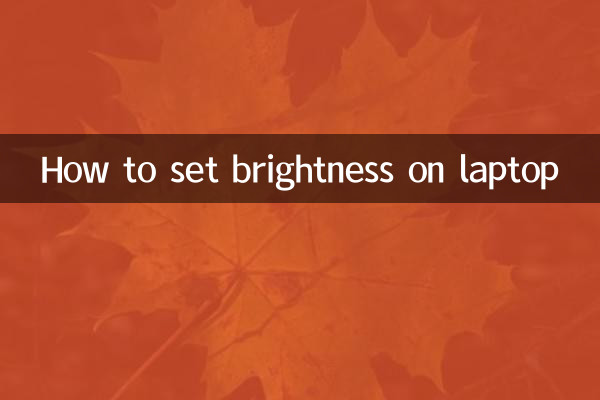How to set brightness on a laptop: hot topics and practical guides on the Internet
Recently, laptop usage tips have become one of the hot topics, especially how to set the screen brightness to protect your eyes and save power. This article will combine the hot content of the past 10 days to provide you with detailed setting methods and practical suggestions.
1. Hot topics and hot content on the entire network

According to statistics from the past 10 days, the following are hot topics related to notebook brightness settings:
| Ranking | hot topics | Discussion popularity |
|---|---|---|
| 1 | Notebook screen brightness adjustment tips | high |
| 2 | How to protect your eyes and reduce screen damage | Middle to high |
| 3 | Laptop power saving mode and brightness settings | middle |
| 4 | Brightness adjustment methods for different operating systems | middle |
| 5 | Night mode and blue light filter | low high |
2. How to set notebook brightness
Depending on the operating system, the method of setting notebook brightness is slightly different. The following are the setup steps for mainstream operating systems:
1. Windows system
(1) Adjustment through shortcut keys: used by most notebooksFn + F5/F6orFn + brightness icon keyAdjust brightness.
(2) Through system settings:Start menu > Settings > System > Display, drag the brightness slider to adjust.
(3) Via power options:Control Panel>Hardware and Sound>Power Options, adjust the screen brightness plan.
2. macOS system
(1) Adjust via shortcut keys: useF1/F2key orTouch BarBrightness slider on.
(2) Through system settings:Apple menu > System Preferences > Displays, drag the brightness slider to adjust.
(3) Automatic brightness adjustment: Check"Automatically adjust brightness", the system will automatically adjust according to the ambient light.
3. Linux system
(1) Adjustment through shortcut keys: supported by some distributionsFn + brightness key.
(2) Through the command line: usexrandrcommand orbrightnessctlTool adjustment.
(3) Through the graphical interface:Settings > Power > Display Brightness, adjust the brightness slider.
3. Best Practices for Brightness Settings
Based on expert advice and user feedback, here are the recommended values for brightness settings:
| Usage scenarios | Recommended brightness | Remark |
|---|---|---|
| Indoor during the day | 50%-70% | avoid reflection |
| night indoor | 30%-50% | Turn on blue light filter |
| Outdoor strong light | 80%-100% | Improve visibility |
| power saving mode | 30%-40% | Extend battery life |
4. Other practical skills
1.Automatic brightness adjustment: After turning on, the brightness can be automatically adjusted according to the ambient light, reducing manual operations.
2.Blue light filter function: When used at night, it can reduce the damage of blue light to eyes and improve sleep quality.
3.Shortcut key customization: Some notebooks support custom shortcut keys, which can set the brightness adjustment to a more convenient combination.
4.Third party tools:likef.lux,Redshiftand other software, which can provide more flexible brightness adjustment options.
5. Summary
Reasonable settings for laptop brightness can not only improve the user experience, but also protect your eyes and save power. Through the methods and techniques introduced in this article, you can easily find the brightness setting scheme that suits you best. If you have other questions or suggestions, please leave a message in the comment area for discussion!

check the details

check the details